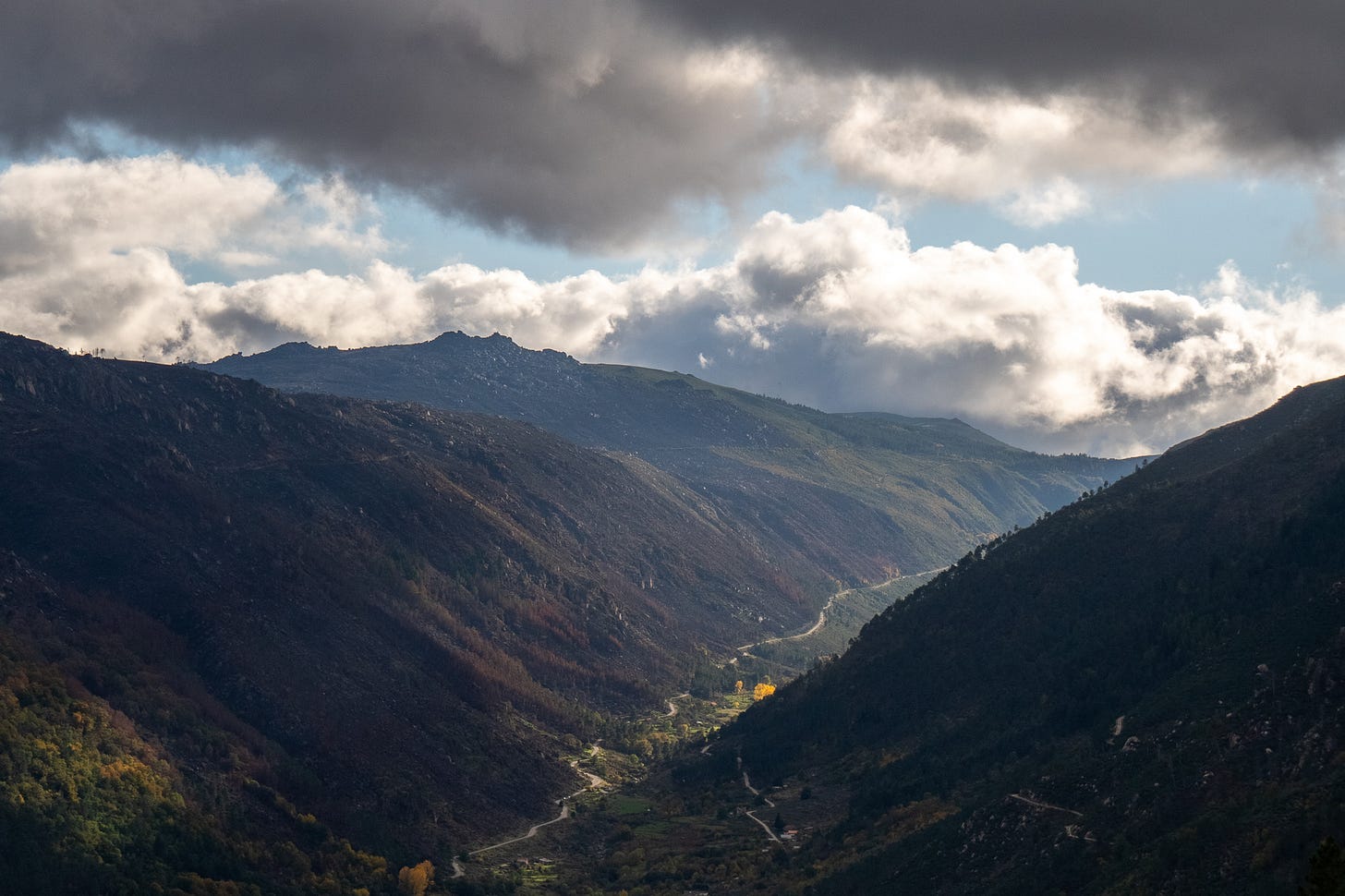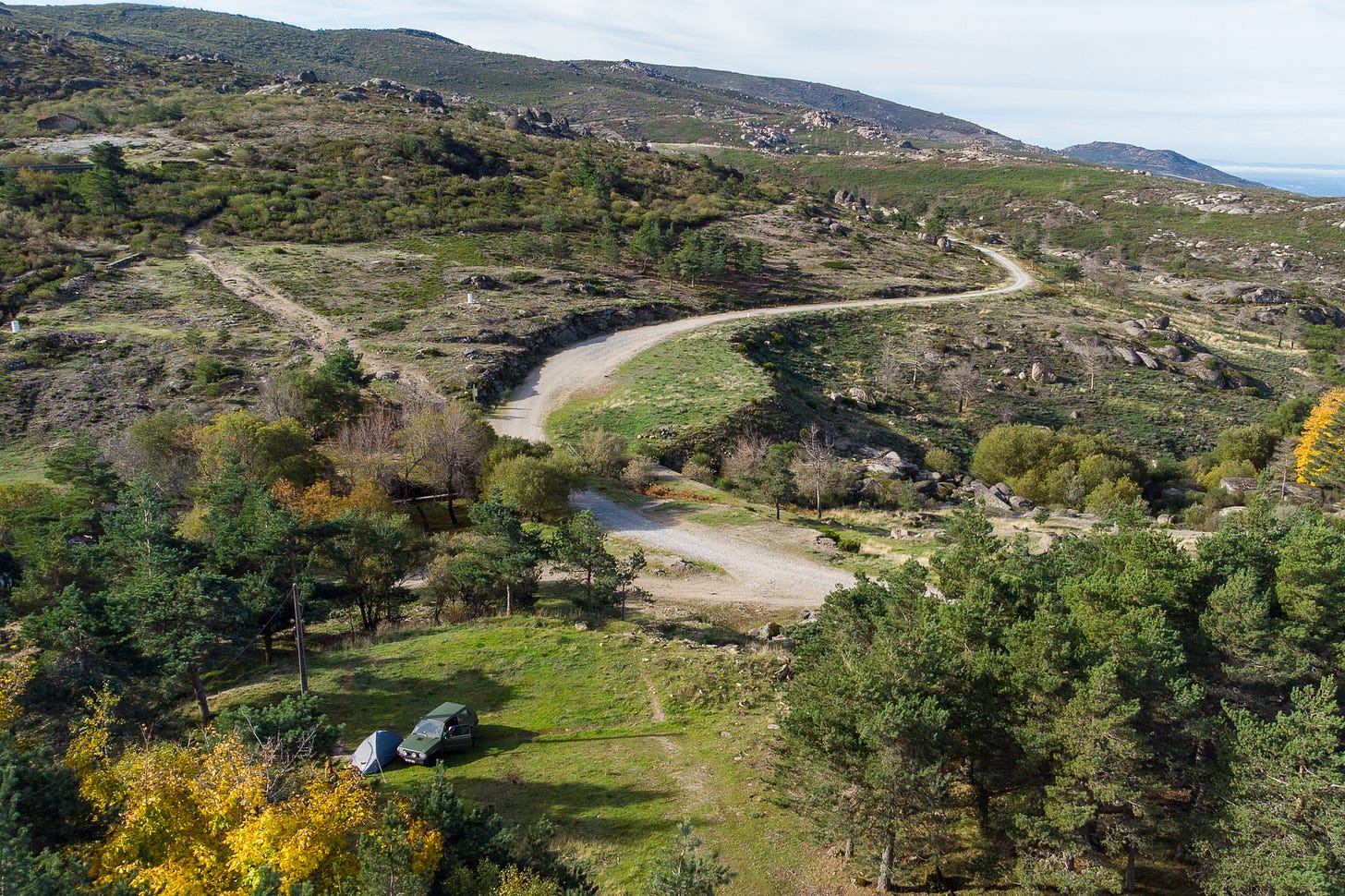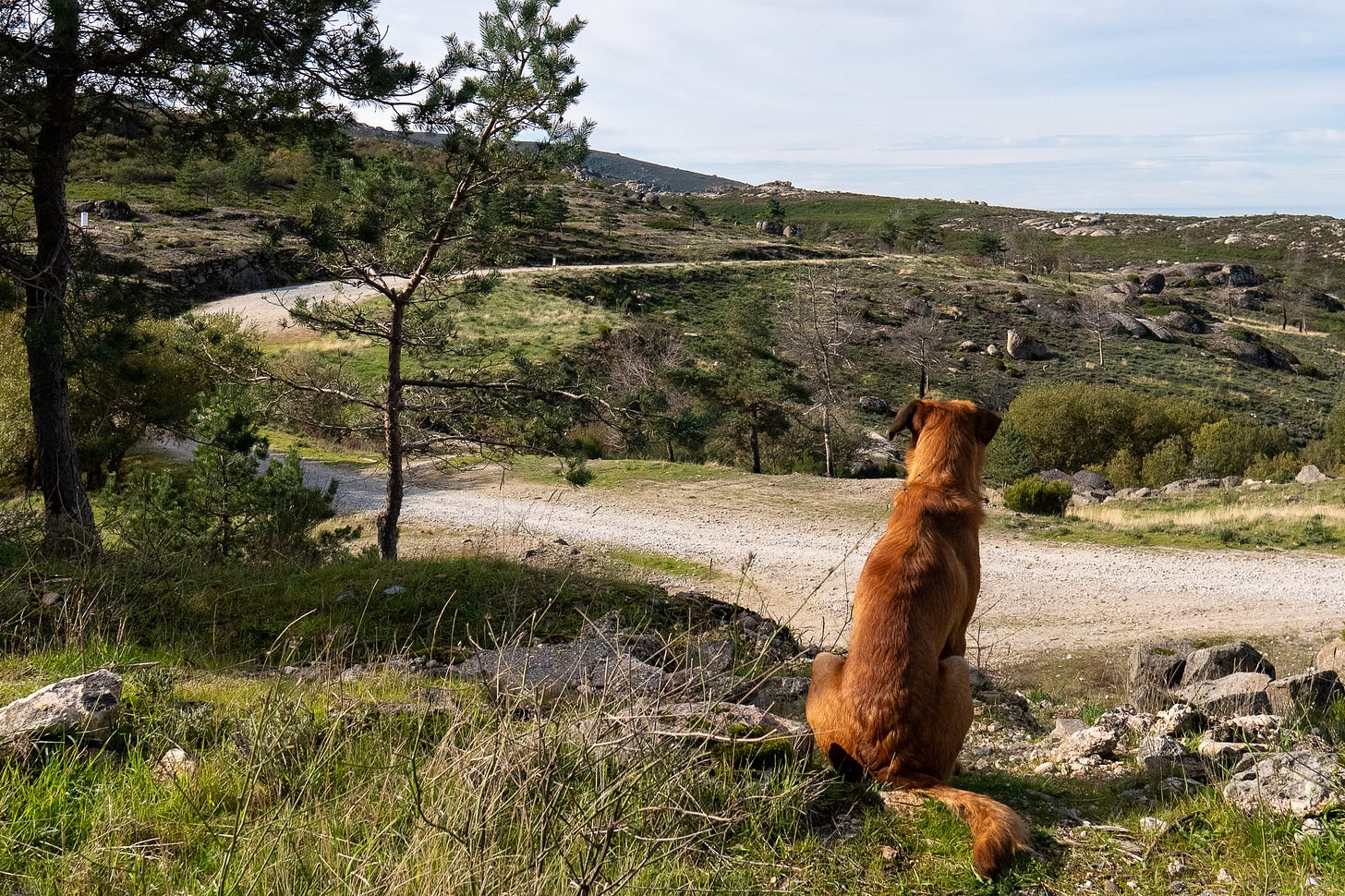Estrela: Above the Clouds
A journey to the highest mountain in Portugal.
Each time I pass here, I ask myself whether this is truly the landscape of Serra da Estrela in the distance. This is mostly due to a mild hysteria from many hours spent driving across the seemingly endless plains of Alentejo, but also due to the unique feeling of wonder that washes over my psyche each time I enter the high mountains. I have been on the road for eight hours elapsed and I feel it deeply. My body is tense from these hours behind the wheel, but the tension dissipates as I begin to soak up the views that are unfolding before me. Green, luscious valleys give way to gigantic, rocky mountains above. I can now clearly see the damage from the summer wildfires. The charred remains of thousands of pine trees stand petrified—what would have once been a sea of green is now an expanse of monotone brown. The damage was widespread and seems to extend for as far as the eye can see.
As I drive into the natural park, the asphalt road snakes its way upwards through the burnt forests—eventually giving way to the areas that weren't reached by the flames. The entire valley is covered in native woodlands of chestnut, oak and sycamore. Autumnal colours appear with splashes of gold. A small settlement reveals itself in the distance—Manteigas, a quaint mountain town that is nestled in the glacial valley of Zêzere. The area is vibrant in colour and buzzes with a natural fertility. In the distance, late afternoon light is funnelled through the clouds, casting its intense beams onto the mountain road that climbs higher into the peaks. I am mesmerised, my sight fixated on this unique display of light, colour and form. Only a few more kilometres remain until I reach my destination—a high mountain lake in the middle of nowhere.
1428 metres altitude. The air is thick with fog and the visibility is low, which adds to the secluded atmosphere. Our camp is established in a small grove of Douglas fir and silver birch, standing like guardians over our temporary abode. It’s time to explore the surroundings. Lupa and I run through the mist along a bumpy trail, dotted with small chunks of granite. This is a lunar landscape, a place otherworldly and bewildering. I feel a hint of nostalgia towards places previously explored—the rugged hills and tors of Dartmoor, similar in both its expansive panorama as well as the geology. Ascending a small ridge, we go off trail—instead opting to hop from boulder to boulder, a motion that feels similar to what I imagine an astronaut to experience. Buoyancy and lightness carry us forward. Time loses its significance and form.
After a mere matter of minutes, the skies begin to open up. A half moon appears, looming overhead. The misty clouds roll away into the horizon, melting over the distant peaks. The sunset lights up the sky, painting smooth brushes across a canvas that fades from midnight blue, to violet, to tangerine orange—the sun transitioning now from one land to another, ready to illuminate someone else's world.
Silence reigns in the high altitude. An engulfing, all pervasive silence. It's perceived not only through hearing but through all of the senses—as well as something deeper, residing above and beyond the material world. I hear a rushing sound in the distance, initially mistaking it for traffic, but it is only the wind passing over the rocks. The cold creeps in gradually. It promises to take over the night. For a moment, I feel concerned about whether I am sufficiently prepared for these temperatures. Either way, it is too late to do anything about it. I climb into my sleeping bag and hope for the best. It won't have been my worst camping experience anyway, after enduring nights below freezing in Welsh mountain huts and on the Cornish coast.
I wake up to frigid temperatures and the sound of a distant airplane soaring thousands of metres above. The sun climbs slowly, too slowly for my cold bones. I take a walk around the lake and find a ruin of a stone house, seemingly dismantled by a fire many years ago. Half of the building is charred. I take a look inside of the stone structure and notice a tree growing within the walls, a species of which I am not familiar. The leaves are auburn, shifting in colour with the change of the seasons. I take a moment to acknowledge the intelligence of nature, that a single seed can find its way and grow through seemingly inhospitable conditions. As I walk back, a raven perched on a branch squawks with a typically taunting sound. In this moment, it is only me and the bird—it is clear who is better adapted to this environment. I squawk back in defiance.
The alpine trees remind of days spent in the high Pyrénées, hardy forests of fir and silver birch, covered in moss and lichen of various earthy tones. My view begins to narrow as I focus on the details of my surroundings, transitioning from the macroscopic to the microscopic. I watch as the morning dew refracts multicoloured rays of light. I pick up the smaller rocks and take note of their composition—chunks of quartzite shimmering in the warm light. It's going to be a beautiful day and I can feel it. The skies are clear, a pastel blue blending with the hazy clouds that fade into the ether. Warmth finally begins to return.
I meet Jamie halfway up the glacial valley of Zézere. Our plan today is to run up to the highest point in Portugal: Torre, 1993 metres altitude. Lupa jumps out of the car with enthusiasm—he has no idea where he’s going and doesn’t seem to care, as long as it involves a long excursion in the wild. Our path forward is a simple one: ascending steadily up the valley, treading the path that glaciers once carved. We take our time, catching up on each others news about what has occurred since we last met. The river flows downward as we climb upward. Hopping over puddles and streams, the foliage changes from grassy meadow to mossy pine trees. I take a moment to inhale the sweetness of the damp forest air, a pleasing contrast to the dry and dusty atmosphere of southern Portugal.
The kilometres tick by as we rise above the tree line. Emerging into a marshy plateau, I find myself once again in the lunar landscape of the high altitude. Granite rock formations and windswept grasslands. My memory is cast back to only a few months prior, when I first visited this region on a previous road trip. The change of the seasons is certainly felt—icy winds blow from the Atlantic and grey clouds loom overhead. I point out the road that climbs to the summit, and the trail that follows parallel along a ridge. We glance upwards and then back at each other, exchanging a mutual excitement and disbelief that we have found what is surely a form of trail running gold. Panoramic views surround us, roads that fall like ribbons over the mountains—twisting and turning with elegance, back towards the lower valleys. Small mountain chalets wait with patience for their winter inhabitants. We continue into the clouds.
Our first glimpse of the summit comes from the radar—once again adding to the outer space theme of this voyage. The wind is bitterly cold on the summit and we opt to keep on moving. Jamie makes a quick call to his wife to inform her of our whereabouts. As we descend over the other side of this plateau, the ruggedness of this land is visible for as far as the eye can see. Giant granite boulders cover the land before us, coated in radioactive-green lichen. There is no discernable trail. We follow a vague line on the GPS watch that doesn’t seem to correspond to any physical path. This would set the theme for what is to come.
The trails here are poorly marked, and we often find ourselves going off-track. The harshness of this environment is echoed in the animal bones that we frequently stumble across. Even the dead branches of the bushes have a skeletal aesthetic, creating the illusion that we are running through a boneyard. This is no welcoming place.
I turn to Jamie and say: “Do you remember that region in the Lion King where the hyenas live, the dark place scattered in bones? This terrain feels a little like that."
I am caught off-guard for a moment and trip on a rock, falling to the floor and scraping my shin across a chunk of granite. Blood begins to seep down my leg but it is not a significant amount, just enough to remind me to pay closer attention. The adrenaline kicks in and gives a boost of forward motion.
The sun is setting much sooner than we anticipated, since our pace over this technically challenging terrain is much slower than expected. The warm glow of the distant sunset fades into the blue haze of twilight. Darkness sets in and we decide to switch on our head torches. For reasons that I cannot explain, the marshy grass takes on a reflective surface in the artificial light, creating a confusing sense of depth perception. Each footstep must be taken carefully, since much of the way is irregular with rocks and lumps of thick grass. Occasionally, a stream passes through and we jump across it. In certain areas, there is what appears to be puddles, but are in fact deep pools of water. On closer inspection, it seems to be deep enough to submerge the average human up to their waistline. Of course, Lupa is unfazed by all of these details. He leads the way for much of the journey as if he already knows where we are going. Completely immersed in the moment, there is not a single sign of complaint from my furry companion.
It is only a few kilometres until we are finally off the plateau, but it feels significantly longer. We are now on the steep single track that leads back down into the glacial valley below. The lights of Manteigas glimmer in the distance, mesmerising in the darkness of night. After traversing nearly thirty kilometres on foot, my entire lower body is feeling the strain.
“Do you ever wonder who decided to actually make this trail?” Jamie asks.
It’s a valid question, considering that many decades ago it was difficult enough to simply survive in these kinds of environments. My mind drifts for a moment. Maybe it was a curious person from the village who wanted to know what lay beyond the distant peaks. Perhaps the trail was carved by packs of wolves that once roamed these lands, or maybe it was simply the erosion of meltwater as it passes over the plateau. The true cause will remain a mystery to us, but whoever or whatever force that created these trails is certainly worthy of respect.





Fascinating but deeply disturbing (as usual)!! Longing to hear from you! xxx